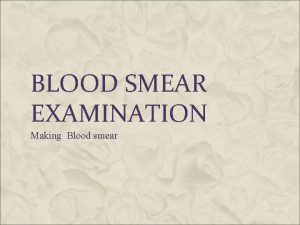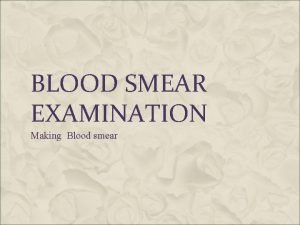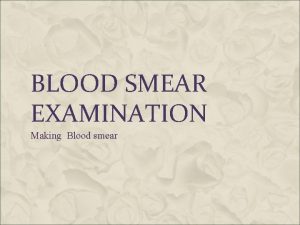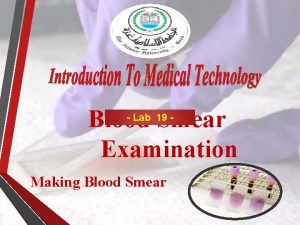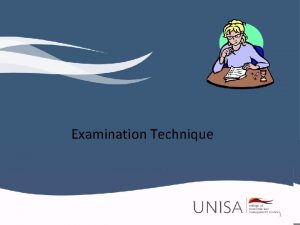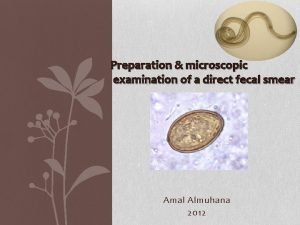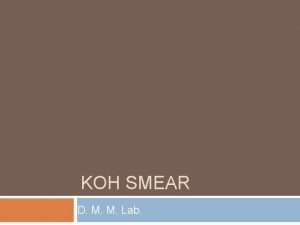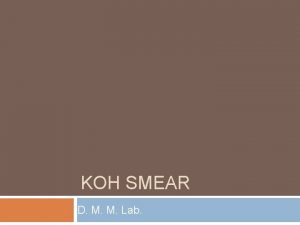Smear Preparation Amar saeed Smear preparation For examination
















- Slides: 16

Smear Preparation Amar saeed

Smear preparation • For examination by microscope we have two type of smear 1. Wet smear (preparation )which is prepare directly for examination 2. Dry smear which it examine after drying the smear

Wet preparation • Advantage 1. Mainly use for fresh sample 2. Use for detection of the manifestations of life like movement (motility) 3. Easy to prepare 4. Not need experience Rapid (Not consume time)

Wet preparation • It can be classify into two 1. Non stain: in this preparation we use to type of diluent (a). Normal saline which is prepare to preserve the vital organ and cells from shrink's or lysis (b). Distilled water it may lead to cell rupture 2. Stained smear

The stain smear • Mainly we can use two type of stain 1. Iodine : which can stain the living microorganism the it safe use because it kill (disinfection) It good for the parasitic sample 2. Eosin : it stain the background , It not stain the microorganism , It good for detection of motility

Dry smear • We have two type of dry smear 1. Thin film: which is need fixation before the stain and it use to see the morphology of blood cell and the type of parasite 2. Thik film: not need fixation , It use to check the present or absent of parasite

i- Preparation of blood smear • There are two types of blood smears: 1. The cover glass smear. 2. The thin smear. • The are two additional types of blood smear used for specific purposes 1. Buffy coat smear for WBCs 2. Thick blood smears for blood parasites.

steps for blood film

Characteristics of a Good Smear 1. Thick at one end, thinning out to a smooth rounded feather edge. 2. Should occupy 2/3 of the total slide area. 3. Should not touch any edge of the slide. 4. Should be margin free, except for point of application.

Common causes of a poor blood smear 1. Drop of blood too large or too small. 2. Spreader slide pushed across the slide in a jerky manner. 3. Failure to keep the spreader slide at a 30° angle with the slide. 4. Failure to push the spreader slide completely across the slide. 5. Irregular spread with ridges and long tail 6. Holes in film: Slide contaminated with fat or grease

Examples of unacceptable smears

Fixing the films • To preserve the morphology of the cells, films must be fixed as soon as possible after they have dried. • It is important to prevent contact with water before fixation is complete. • Fixation by: 1. Methanol 2. ethyl alcohol ("absolute alcohol") 3. spirit (95% ethanol)

Staining the film Romanowsky staining: are universally employed for staining blood films and are generally very satisfactory. • There a number of different combinations of these dyes, which vary, in their staining characteristics. 1. Giemsa is a good method for routine work. 2. Wright's stain is a simpler method. 3. Leishman's is suitable stained blood film 4. Field's stain is a rapid stain used primarily on thin films for malarial parasites

too acidic suitable too basic

Glass slides for microscopy Label slides individually • use glass marking pencil • ensure markings don’t interfere with staining process Each slide should bear: • patient name • unique identification number • date of collection

Any questions …!!!
 Estou aprendendo a amar
Estou aprendendo a amar John i saeed
John i saeed Dr aamir saeed
Dr aamir saeed Dr farah saeed
Dr farah saeed Saeed sharifi
Saeed sharifi Dr ayaz saeed
Dr ayaz saeed Saad azhar saeed ucp
Saad azhar saeed ucp Saeed khan wayne state
Saeed khan wayne state Flucytosine mechanism of action
Flucytosine mechanism of action Saeed al ghamdi
Saeed al ghamdi Tashfeen saeed
Tashfeen saeed Dr ayaz saeed
Dr ayaz saeed Kung som dog 1611
Kung som dog 1611 Förklara densitet för barn
Förklara densitet för barn Elektronik för barn
Elektronik för barn Tack för att ni har lyssnat
Tack för att ni har lyssnat Mall för referat
Mall för referat

















